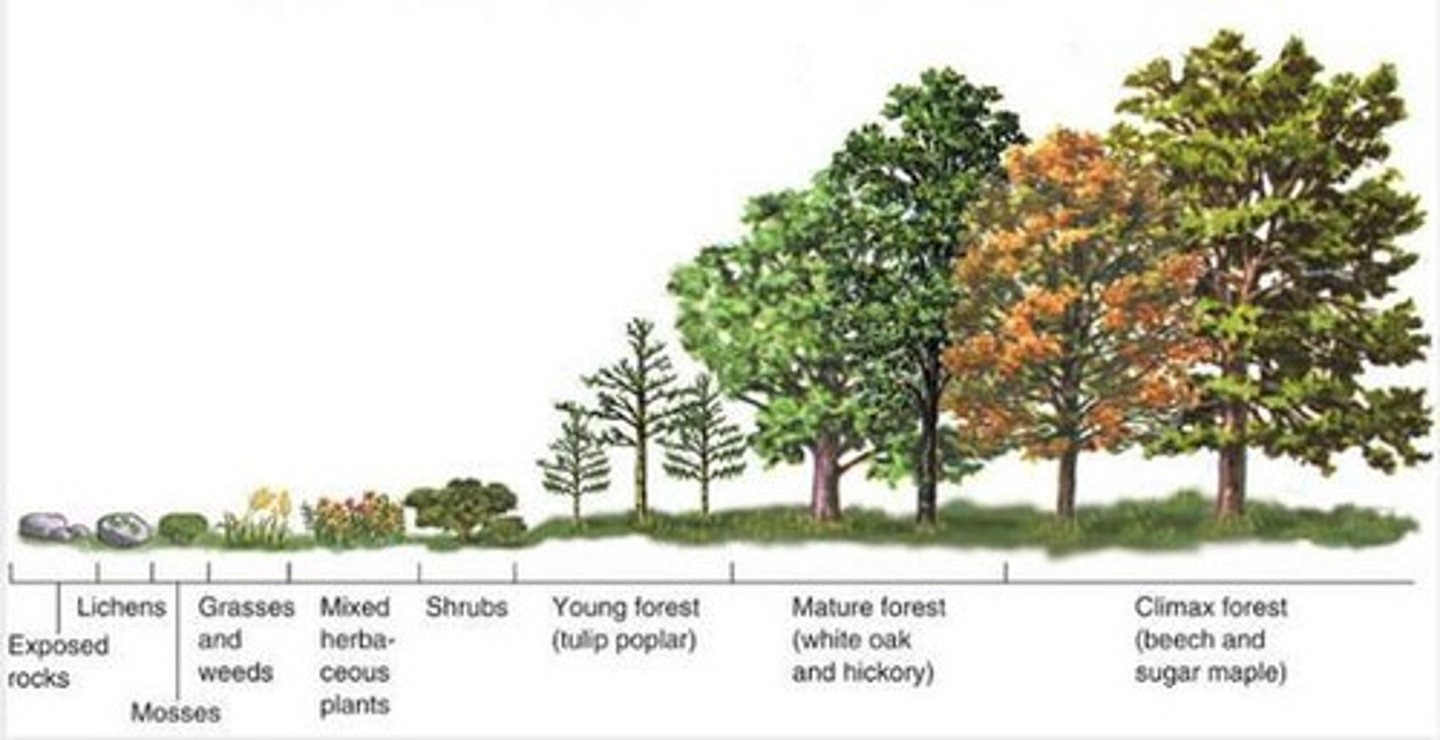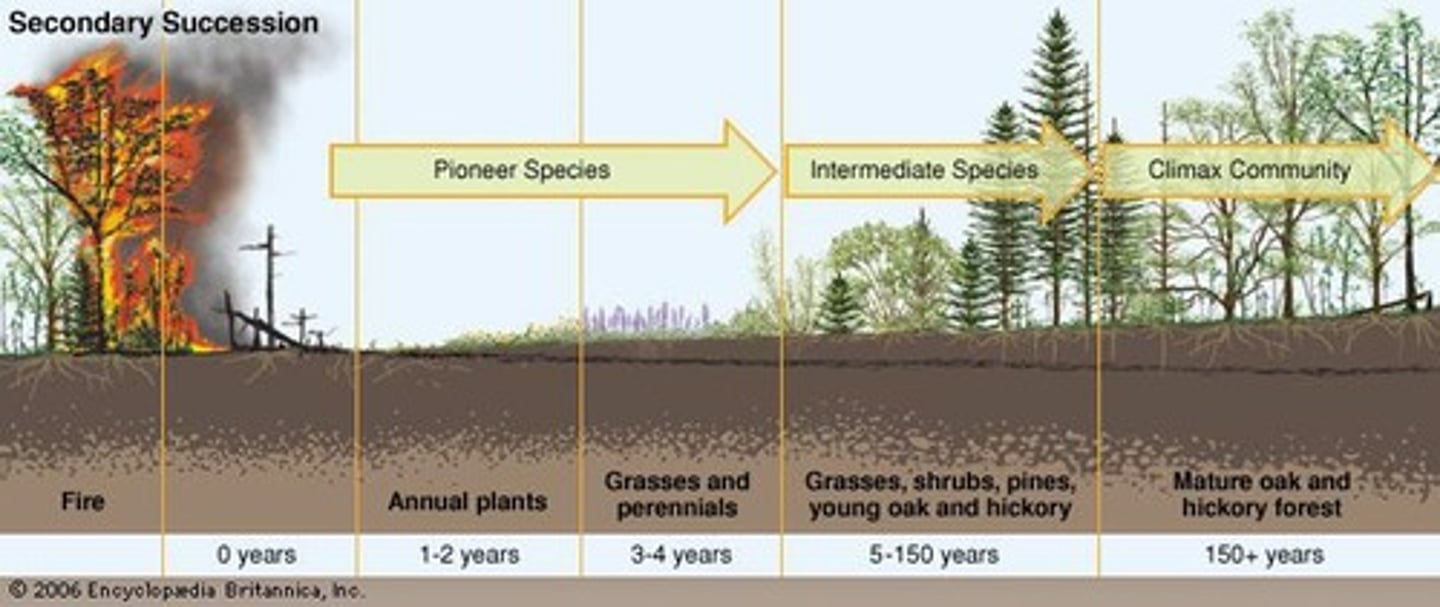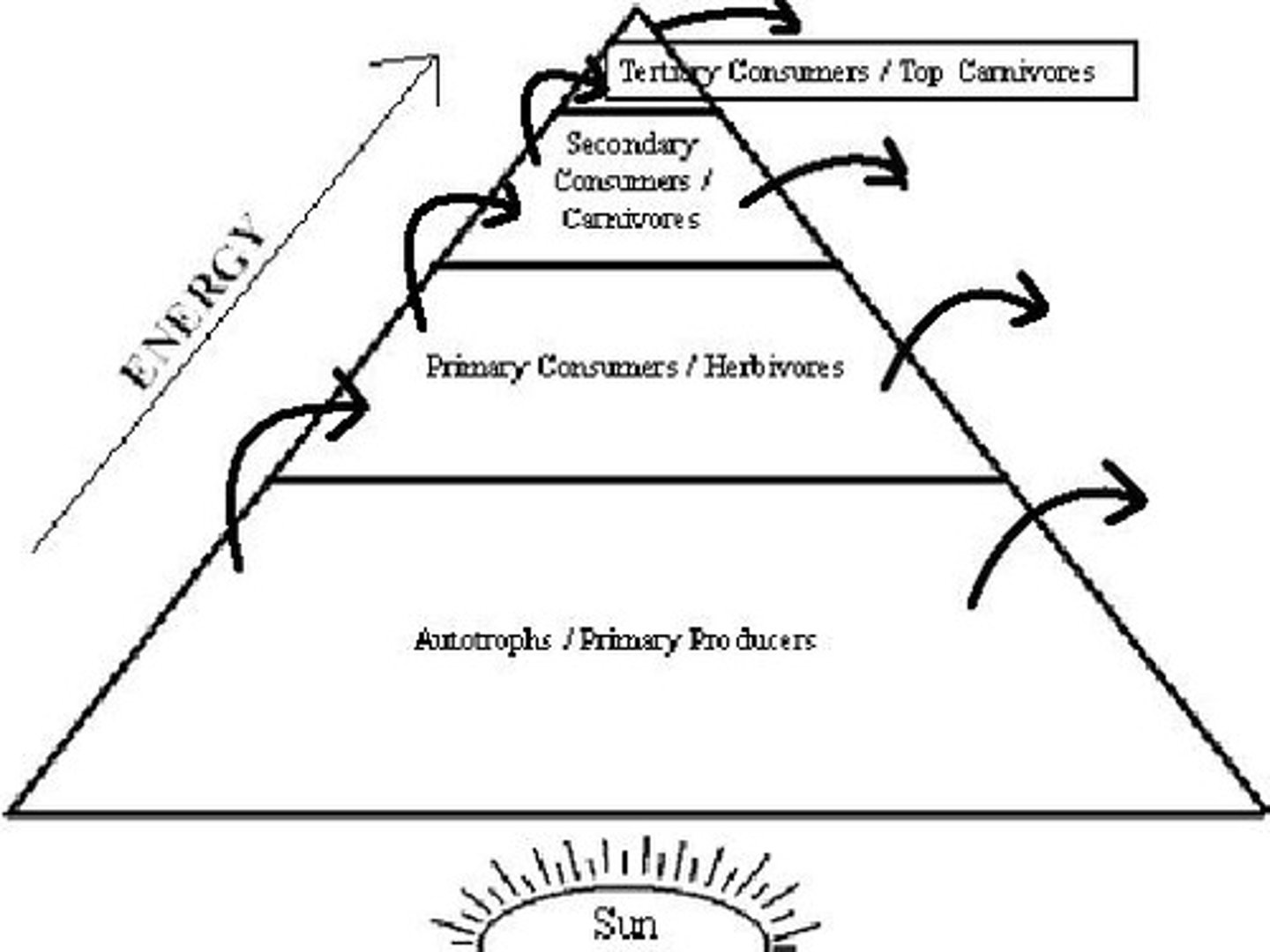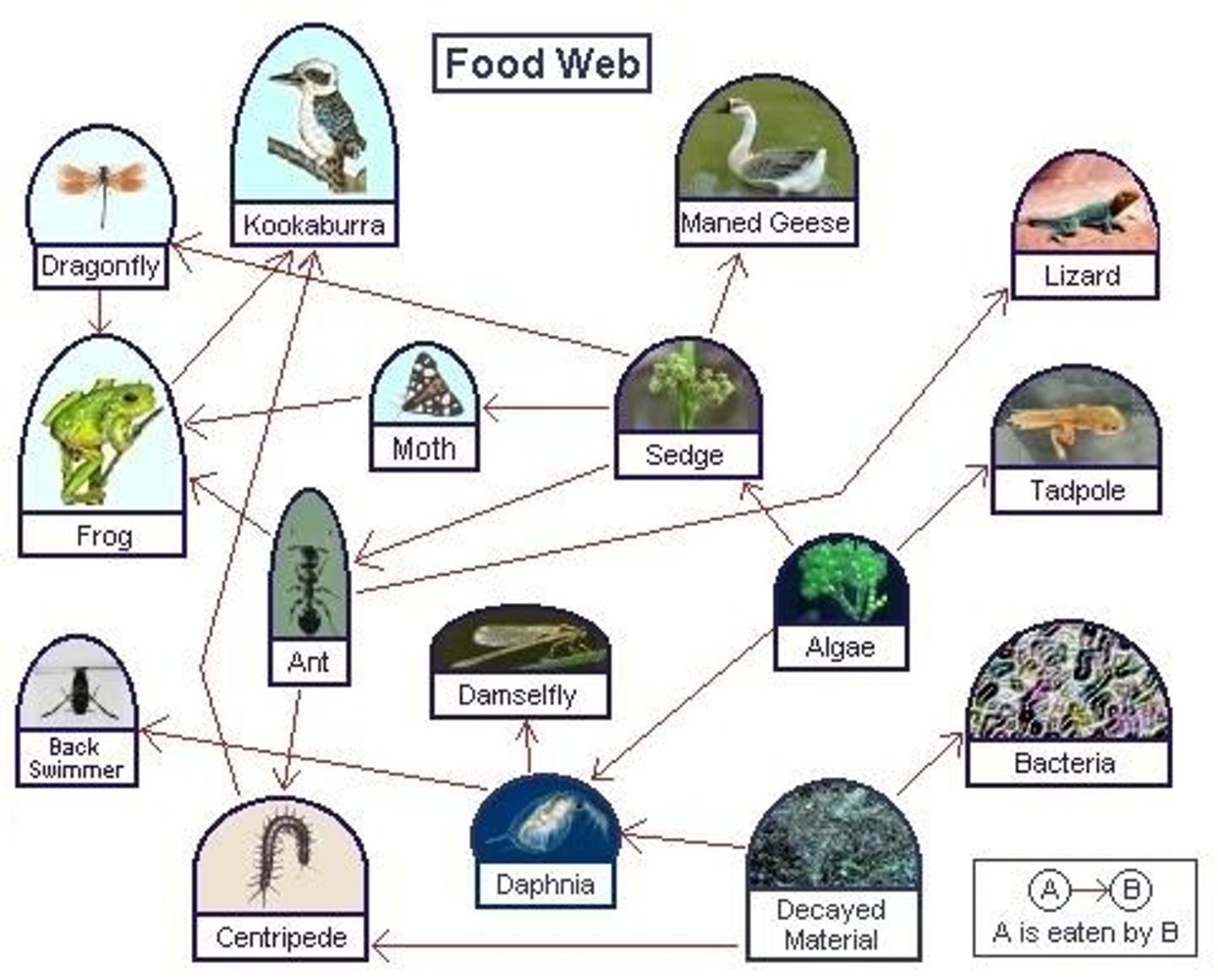Ecological Succession, Relationships, and Biomes: A Comprehensive Biology Review
1/94
There's no tags or description
Looks like no tags are added yet.
Name | Mastery | Learn | Test | Matching | Spaced |
|---|
No study sessions yet.
95 Terms
Ecological Succession
Series of changes that occur in an ecological community after a disturbance.

Primary Succession
Occurs on sites that lack living organisms and where no soil is initially present.
Pioneer Species
Species that colonize an uninhabited area and begin the ecological cycle so other species can inhabit the area.
Lichens and Moss
Pioneer species since they grow on bare rock and produce the soil that allows other life to begin.
Secondary Succession
Occurs on sites where some organisms have survived the disturbance and where soil is present.

Climax Community
The stable, fully grown state of a community at the end of ecological succession.
Autotrophs
Organisms that produce their own food, such as plants, algae, trees, grasses, plankton, flowers, and seaweed.
Heterotrophs
Organisms that cannot produce their own food and rely on consuming other organisms.
Primary Producers
Autotrophs that are the first level in the energy pyramid.
Primary Consumers
Herbivores that consume primary producers.
Secondary Consumers
Carnivores that consume primary consumers.
Tertiary Consumers
Top carnivores that eat meat and are not naturally hunted/eaten by anything else in the wild.
Omnivores
Organisms that eat both plants and animals.
Detrivores
Organisms that eat organic waste and dead bodies.
Decomposers
Heterotrophs that break down organic material and cause decay, returning nutrients to the soil/water.
Energy Flow in Ecosystems
The flow of energy through ecosystems is linear because energy cannot be reused by organisms.
Photosynthesis Equation
H2O + CO2 + (light) energy → O2 + C6H12O6.
Energy Transfer Efficiency
Each trophic level receives only 10% of the energy from the previous level.
Energy Loss
90% of the energy is lost as heat during energy transfer between trophic levels.
Energy Pyramid
A diagram that shows decreasing energy flow through the four trophic levels.

Trophic Levels
1st level = autotrophs, 2nd level = primary consumers, 3rd level = secondary consumers, 4th level = tertiary consumers.
Tertiary Consumers / Top Carnivores
Ex: lion, hawk, wolf, shark, orca
Secondary Consumers / Carnivores
Ex: spider, snake, trout, frog, seal
Primary Consumers / Herbivores
Ex: rabbit, deer, mouse, grasshopper, koala
Autotrophs / Primary Producers
Ex: plants, algae, trees, grasses, plankton, flowers, seaweed
Energy Flow
Describes who eats whom in an ecosystem
Food Chain
Describes the sequential passage of energy, must start with a producer and shows who eats whom

Food Web
Shows the complexity of the interconnected food chains, several food chains woven together, and shows how every organism is interdependent
Biomass
The combined weight of all the organisms in a trophic level
Predation
The act of killing and eating another organism
Coevolution
When two species influence each other's evolution
Keystone Species
Plays a major role in a community and affects many other species; removal of this species greatly impacts the community
Indigenous Species
Growing and existing naturally in a region; a native
Exotic Species
A non-native organism deliberately or accidentally introduced into a new habitat
Biological Magnification
Process in which pollutants become more concentrated in successive trophic levels
Pollutants in Biological Magnification
Often harms the organisms in which these materials concentrate, since the pollutants are often toxic
Impact of Exotic Species
Can have many negative impacts on the environment, the economy, and human health
Effects of Pollutants
Pollutants that magnify tend to be taken up by producers at a higher than normal rate
Storage of Pollutants
The pollutants are absorbed and stored in the bodies of consumers (usually in the fat)
Example of Exotic Species Impact
Approximately 68% of fish species lost in North America over the last century were caused by an invasion of exotic species
Biomagnification
The process by which pollutants build up in the fatty tissues of consumers.
DDT
A pesticide used for a long time to kill disease-causing insects, which does no real damage to some organisms, including humans, but is deadly or has long-term effects on other species.
Population
A group of individuals of the same species living in a specific area.
Population Growth Factors
Three factors that control population growth: Births, Deaths, and Migration.
Immigration
The movement of individuals into a population.
Emigration
The movement of individuals out of a population.
Limiting Factor
Any factor that restrains the growth of a population, such as disease, parasites, predators, or availability of resources.
Density-independent Factors
Limiting factors that affect a population's growth regardless of its size, such as natural events and human activities.
Density-dependent Factors
Limiting factors whose impact on a population's growth is affected by the population size.
Growth Rate
The rate at which a population increases or decreases, indicated by the difference between birth rate and death rate.
Exponential Growth
A growth pattern where births consistently exceed deaths, creating a 'J-shaped' curve on a graph.
Logistic Growth
A growth pattern where populations show an 'S-shaped' curve as they reach carrying capacity.
Carrying Capacity
The maximum number of organisms a given area can support.
Nutrient Flow
The flow of inorganic nutrients through an ecosystem, which are recycled.
Reservoir
A storage site for nutrients in biogeochemical cycles.
Water Cycle
The cycle that includes evaporation, transpiration, and precipitation, with gravity playing a key role.
Transpiration
The process by which water vapor is released from plants, chiefly at the leaves via their stomata.
Carbon Cycle
The cycle that involves photosynthesis and respiration as the basis for carbon movement in ecosystems.
Photosynthesis
Plants take in CO2 & give off O2.
Respiration
Use O2 & give off CO2.
Fossil Fuels
Remains of organisms transformed by decay, heat, and pressure into energy-rich molecules (Ex: coal, oil, natural gas).
Nitrogen Cycle
N2 must be converted to a usable form for organisms through nitrogen fixation.
Nitrogen Fixation
Process where nitrogen gets 'fixed' by bacteria into forms usable by organisms = nitrate (NO3) or ammonia (NH4).
Nitrate
Form of nitrogen that most plants can take up and convert to amino acids.
Amino Acids
Acquired by animals when they eat plants or other animals.
Ammonia
Returned to the soil or water when organisms die or release waste, usually from decomposers.
Nitrite
Less toxic form of nitrogen that bacteria convert ammonia into.
Denitrifying Bacteria
Convert nitrate back into nitrogen gas (N2), which returns to the air.
Phosphorus Cycle
Phosphate is never a part of the atmosphere; it will always be in one of three forms: part of an organism, dissolved in water or soil, or in the form of rock.
Habitat Destruction
Ex: 98% of all tropical rain forests have been destroyed.
Ozone Layer
Protects Earth from harmful UV rays; its breakdown increases skin cancer occurrence and damages plant photosynthesis.
Greenhouse Gases
Examples include methane, CFCs, & CO2; they trap heat from the sun.
Global Warming Effects
Negative effects include changing temperature and precipitation patterns, increases in ocean temperatures, sea level, and acidity.
Acid Rain
Has a pH of 4.0-4.5 (Normal=5.5).
Biodiversity
The variety of life in the world or in a particular habitat or ecosystem.
Endangered species
Species that are in danger of going extinct.
Rate of extinction
Currently at an all-time high, with estimates of 50-150 species becoming extinct each day.
Reasons for extinction
Factors contributing to extinction include climate change, toxins in the environment, habitat destruction, and introduced species.
Balanced ecosystems
Ecosystems that maintain stability and health, which can be disrupted by the extinction of species.
Medicinal use of species
The potential for discovering medicines and other products from various species.
Biomes
Large terrestrial regions characterized by similar climate, soil, and living things.
Tundra
Cold, boggy plains characterized by permafrost, located far north or at high altitudes.
Taiga / Boreal Forest
Cool weather, evergreen forests of northern areas, primarily consisting of conifer trees.
Deciduous Forests
Forests with a dense canopy of mostly deciduous trees that lose their leaves in fall/winter.
Temperate Grasslands
Grass-dominated areas found in temperate regions, characterized by nutrient-rich soil and few trees.
Savannas
Tropical grasslands with scattered trees, experiencing seasonal rainfall and drought.
Chaparral
A temperate biome with hot, dry summers and mild winters, often adapted to fire.
Deserts
Arid ecosystems defined by a lack of rainfall, with extreme temperature changes and specially adapted organisms.
Tropical rain forests
Lush ecosystems located along the equator, known for their high biodiversity and year-round rainfall.
Permafrost
Ground that never completely thaws, characteristic of tundra biomes.
Conifers
Evergreen trees that produce cones and have needles instead of leaves, typical in taiga forests.
Nutrient-rich soil
Soil that is fertile and well-suited for agriculture, often found in temperate grasslands.
Adaptations to dry conditions
Special root systems and hard leaves in plants that help them survive in chaparral and desert biomes.
Extreme temperature changes
The significant difference in temperature between day and night in desert ecosystems.
Greatest biodiversity
Tropical rain forests have the highest diversity of species compared to all other biomes combined.